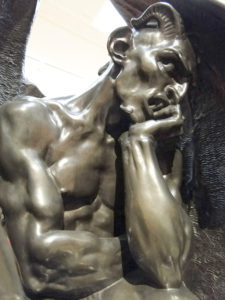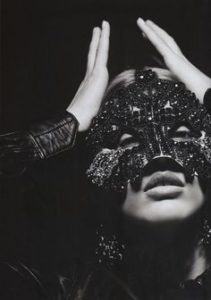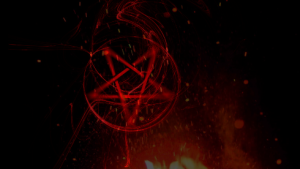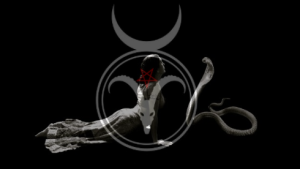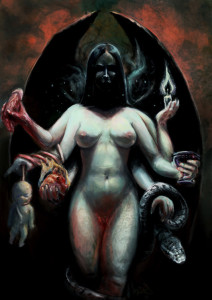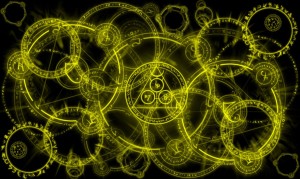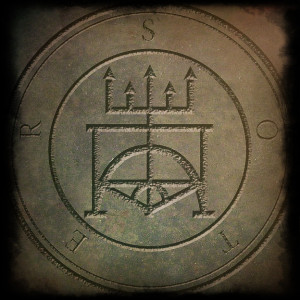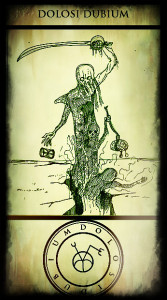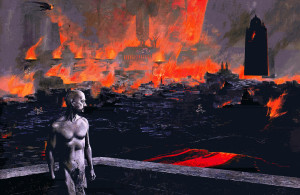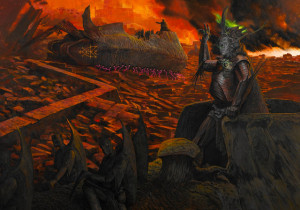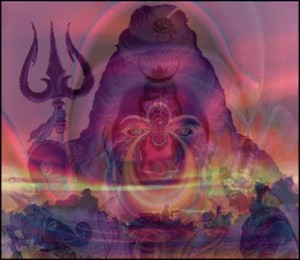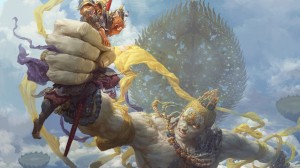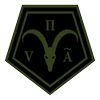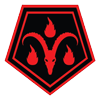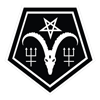What is the importance of the Left Hand Path?
By Zelzaa Crowley
There are many out there who claim to be satanist but are not truly on the Left Hand Path. I would venture to say that many of them do not even truly know what it is. Being on the Left Hand Path is a journey towards self-deification.
BUT WHAT DOES THAT MEAN?
All gods and goddesses are truly creations of mankind. We are our own God and our own devil. Satanism uses satan as a symbol of the carnality of man and our obligation and duty to serve ourselves first. Why would I want to surrender myself and deny all of my natural urges for the sake of another being?
If all gods and religions were truly formed and invented by men anyway, and they were, then why not make a god from myself and exalt and glorify myself. After all, I am the most imporant person in my world.
But in order for me to realize a place where I am worthy of such self-deification I must first free myself from the bondage of past thought and dogma and free my thinking to follow after my own desires and serve myself since I am god of my own world. This then involves acknowledging my own desires instead of abstaining from them. For instance, if I want sex instead of abstaining from it or, worse, partaking and then beating myself up for it, I will just simply fulfill my desire without any guilt or condemnation since I am god of my own world and I create the rules by my own desires.
I believe this is truly what is meant by self-deification. Rather than serving another being, I am serving myself and pandering to my own needs and desires first. I am ruling my own world as a god. This can only be done after one has abandoned all faith and hope in serving or believing in any other god.
It is through ritual that we come to terms with our own emotion and desires. It is through study and meditation that we come to understand these things.
The invocations of Satan do not bring some outside, powerful, demonic force into us. No. It simply awakens the black flame of individuality inside of us and brings us to terms with the “dark side” of our own natures. This is truly the essence of the LHP. I am my own god. What the religious world has declared “evil” and “sin” or “satanic” I embrace as a part of my nature and no one can condemn me for it because I am not bound by their dogmatic BS. I am my own god and I am my own devil. Coming to terms with that is the path to self-deification. Ave
Sins
Bad Boy
By William S.
Sect of the Horned God Member
The Left Hand Path (LHP) is the road less traveled, the often misunderstood ‘Bad Boy’ of the Neo-Pagan movement today. Many in the General Pagan Community (hereafter the GPC) would rather we did not exist and try and ignore us as much as possible. The GPC feels a need to distance itself from ‘Satanism’ to the general public both as a means of appearing non-threatening to them and superior, somehow, to us. During the last 20+ years in the Bluegrass region, I have many times heard a Wiccan interviewed on local television say something along the lines of; “We are Wiccans, we worship nature and the great goddess. We aren’t evil like the Satanists. No, we are not coming from that space at all!” Barf, gag……
Of course there are reasons for this. The survival instinct in humans is strong and the Fluff Bunnies fear persecution and retribution. Those of us old enough to have lived through the ‘Satanic Panic’ can actually relate to this, despite the pandering of the GPC to John Q Public. Members of the GPC who are Right Hand Path (RHP) do not understand us, and distance themselves to reinforce their ‘good guy’ image. We have to remember the Occult revival in the United States hit full stride in the 1960’s, and often reflects the Hippie Flower Child beliefs of that era.
The great irony on the last point is that the Left Hand Path had its own ‘revival’ during the same time period. And wonder of wonders, the LHP traces it origins to the ‘City by the Bay’ also! However, rather than Haight-Ashbury Park, our link is to the Black House of one Anton Szandor LaVey. And never the twain shall meet, except perhaps for our friends at The Satanic Temple, but I’ll leave that discussion for another essay.
The Right Hand Path pagans are no different from the more mainstream religions in that they seek union with the godhood, no matter what that may be called. Buddhists seek Nirvana and Christians Heaven, to name just two. The RHP pagans may cross the Abyss in Thelema or seek Summerland or Valhalla. The Left Hand Path practitioner, or “Black Brother,” as Aleister Crowley would call us, do not seek this union with the divine, but rather to keep our Ego as we seek self enlightenment, or self deification, to be more exact.
Black Magicians thus stand apart from the mainstream faiths and the New Age warriors or Neo Pagans, blindly casting stones and going on about the power of crystals. We have no master but ourselves, and seek no validation from others. We operate from the perspective of rational self interest and do waste energy or time on ingrates, and those whom do not share our path. While this may seem evil to the RHP, the Black Magician is the ultimate individualist and realizes that before he is good to others, he must be good to himself first. We leave the often ‘holier than thou’ altruism to others.
We have come a long way since that fateful evening, April 30th 1966. Magus LaVey opened a Pandora’s Box, the end result of which even he did not foresee. Satanism has spread and diverged into many groups. But at its core the LHP remains the province of the individual, working toward self deification, the highest expression of life on earth.
Aleister Crowley Goes to Hell: A Short Essay on the Great Beast and the Left-Hand Path
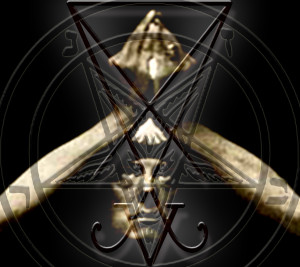
by Paul Fecteau, member of The Sect of the Horned God
The uninitiated have reason to associate Aleister Crowley with satanism. He did, after all, refer to himself as the Beast 666, and it is well known in mainstream culture that 666 has something to do with the Devil, at least if heavy metal lyrics are to be trusted. Indeed, Crowley in the popular imagination amounts to the villain in a slick supernatural horror film–inscrutably he stares, black robe clad, until the orgy scene.
This image of the Great Beast is so pervasive, in fact, that it grips even those ostensibly knowledgeable of the occult. Consequently, one of the most eloquent explicators of Crowley’s ideas, Lon Milo DuQuette, peppers his prose with disclaimers about devil worship. In Understanding the Thoth Tarot, he makes a wide and rather eloquent pitch:
It is understandable that anyone with a Christian background would recoil in horror when he or she first encounters Crowley’s shocking use of words and imagery, such as the Beast 666, Scarlet Woman, All-Father Chaos, Whore of Babylon, or blood of the saints. While these dark ‘blasphemies’ effectively serve to screen out faint-hearted dabblers (and all who choose to remain self-blinded by superstition), they offer a radiant and altogether wholesome spiritual treasure for anyone bold and tenacious enough to do a little research (and a little meditation). (34–5)

Even for those of us partial to a little Hellfire, DuQuette has a point. Crowley’s writing reflects a mind far too complex to be reduced to any stereotype, let alone that of a debauched diabolist, even if his conduct occasionally fit such a label.
Consider Crowley’s Liber 777, the bulk of which comprises the “Tables of Correspondence,” fifty-some pages of charts, anchored by the Qabalah, cross-referencing the sephiroth with the elements, the zodiac, and the tarot, and concepts far more obscure. It’s the Enigma machine of comparative religion. One imagines a sequestered scholar devoting a chunk of years to such a work, but Crowley prepared it during a week’s stay in Bournemouth, drawing up the charts without benefit of reference material (“Editorial Preface” vi). He intended it as a teaching tool, closing the preface with an encouraging note to students:
Many columns will seem to the majority of people to consist of mere lists of senseless words. Practice, and advance in the magical or mystical path, will enable little by little to interpret more and more (sic). (xvii)
Liber 777 demonstrates Crowley’s encyclopedic knowledge of religious symbolism. For him, mysticism was a language, and he became its poet laureate.
The Great Beast’s inexhaustible vocabulary is not, however, in itself, sufficient to explain his adoption of a demonic moniker. The fire-and-brimstone preachers to whom he was subjected in his youth had an impact on him, but he was not of their ilk. He took on the title of Master Therion in an echo of the Book of Revelation because he saw himself as the initiator of a new aeon which would wipe away the bluster of the bible-thumpers.
These days, it’s run of the mill to have a scary pseudonym, particularly online. Though few of those who do are any more like a cartoonish devil-worshipper than Crowley was, many do identify as satanists. It is, therefore, worth noting that Crowley did not. In fact, in the last chapter of “Magick in Theory and Practice,” he specifically dismissed both black magic and the left-hand path, treating each as a distinct misstep.
As we would expect, Crowley avoids the facile definition of “black magic” as done for naughty purposes, seeing it instead as done without legitimate purposes, legitimacy defined by his elaborate cosmology, at the core of which is the maxim “Do what thou wilt shall be the whole of the law.” Oft quoted but just as often misunderstood, the line ranks as one of his ideas that have been regarded as infernal. Crowley wasn’t endorsing carnality, per se, but pronouncing that each individual has a purpose that if pursued will bring fulfillment and if denied will result in futility. Using occult knowledge to do other than one’s Will ranks as “black magic” in Crowley’s book, and that definition explicitly includes all the clichés of the New Age movement: “Christian Scientists, Mental Healers, Professional Diviners, Psychics and the like, are all ipso facto Black Magicians” (Magick 276).
Sorting through the caveats and footnotes to the caveats, typical of Crowley’s dense style, it becomes clear that acts traditionally defined as “evil” do not in all cases meet the definition of black magic. Crowley includes an anecdote about an adept who “found it necessary to slay a Circe who was bewitching brethren” (Magick 279). This man crept to the woman’s bedroom door and thereon carved an “Astral T (traditore, and the symbol of Saturn) with an astral dagger” and “within 48 hours she shot herself” (Magick 279).
Crowley’s rejection of the left-hand path is less fraught with random oddity but just as dependent on his complicated system, specifically the advanced stage of initiation via which one becomes a Master of the Temple. Doing so entails surviving the Horror of the Abyss during which the self is annihilated and the adept achieves synchrony with the universe. Those whom Crowley terms “the Black Brothers” advance to the abyss but there refuse to surrender their blood to Babalon’s cup (Magick 276-7); in other words, treaders of the left-hand path insist on their individuality and avoid any spiritual assimilation. Conceptually, such a definition of the left-hand path would likely appeal to any modern satanist, even if Crowley claims they will ultimately wind up “shreds strewn in the abyss” (Magick 277).
In particular, it would seem that contemporary theistic Satanists would be engaged not only by thumbing their noses at the Horror of the Abyss but by Crowley’s supernatural trappings. The Temple of Set’s founder, Dr. Michael Aquino, whom Setians refer to as the Second Beast, picks up on Crowley’s implication that initiates travel one path — no left hand or right hand to it — until the Ordeal of the Abyss, and Aquino argues that remains true afterwards:
The inevitable conclusion is that there is no Right-Hand Path to the initiatory level of Magister Templi. . . . There is only the Left-Hand Path, and it is fraught with danger — not a one-time crossing of the Abyss test, but a continuous peril that exists from the moment the individual completely realizes him-Self as a Magister. (qtd. in Flowers 147)
In that case, it would seem that Crowley was one of the Black Brothers all along — he just didn’t realize it.
If you are waiting for Satan to jump out of that inky abyss, you are out of luck. In that same chapter on black magic, Crowley proclaims, “The Devil does not exist. It is a false name invented by the Black Brothers to imply a Unity in their ignorant muddle of dispersions” (Magick 277). Atheistic satanists, of course, knew this all along and should not shy away from Crowley. At least, we ought to be able to summon a little more intellectual backbone than the right-hand pathers who ignore DuQuette’s appeals as they browse in New Age bookstores that also sell yoga mats. Indeed, anyone willing to engage Crowley’s occult universe as operant in the psyche of each individual stands to gain from study of his writing, provided there is also a willingness to forge on when confronted by those darkest of spaces that make us human.
Works Cited
Crowley, Aleister. 777 Revised. 1909. Leeds: Celephaïs Press, 2006.
___, Magick (Liber ABA: Book Four). 1913. San Francisco: Weiser, 2008.
DuQuette, Lon Milo. Understanding Aleister Crowley’s Thoth Tarot. San Francisco: Weiser, 2003.
Flowers, Stephen E. Lords of the Left Hand Path: A History of Spiritual Dissent. Smithville, TX: Rûna-Raven, 1997.
“The Ember”
by Blake Reed, member of The Sect of the Horned God
A single Ember arches and twirls through the droplets of a storm; terrified for its existence, disgusted by the presence of the rain, yet enthralled by the beauty of it: a gleaming reflection of itself pulses across the surface of each earthbound globule…
How strange the realization that the heart of the enemy can carry such resemblance to the Ember, e’er searching for companionship (or a nemesis?) yet only finding that which lies betwixt…
and how unjust and cruelly the Ember is seen to be! All too aware of the destruction and chaos it could wreak, how the whole of the world considers it to be a bringer of death, as if the dwindling bloodline of the fiery giants in tales of olde… Yet here sways the Ember, at the mercy of winds, miraculously persevering in (subjectively) cataclysmic conditions.
Should the Ember find home amongst its brethren, would it not be outcast to Nature? Has all the world forgotten that, in ancient times, this Ember was as a god; an irreplaceable staple in the survival of humanity? It seems that bare appreciation and understanding have almost entirely left the meta-vocabulary of man, who seeks only to wholly worship and obsess, or to cast out in disdain.
Kindled amongst Kin,
Extinguished by the monsoon, or
Ascended by lightning…
Through Will, the Ember needs only make this choice its own.
The Serpent, Lilith and the Kundalini
by Thomas LeRoy
“The daimon of sexuality approaches our soul as a serpent.” — Carl Jung
Serpents play a role in much of the world’s mythological traditions. They can be found on both the left and the right-hand paths, representing life, death, sex, creation and destruction. They symbolize the need for transformation, the chthonic, the female aspect in the unconscious, and also wisdom.
“More especially the threat to one’s inmost self from dragons and serpents points to the danger of the newly acquired consciousness being swallowed up again by the instinctive psyche, the unconscious. The lower vertebrates have from earliest times been favourite symbols of the collective psychic substratum, which is localized anatomically in the subcortical centres, the cerebellum and the spinal cord. These organs constitute the snake. Snake-dreams usually occur, therefore, when the conscious mind is deviating from its instinctual basis.” — Carl Jung, “Archetypes of the Collective Unconscious”, page 166.
Lilith, ancient goddess of the left-hand path, is synonymous with sexual desire and the serpent that suggested Eve eat from the Forbidden Tree. She is a representation of the Great Goddess, a fusion of the carnal with the spiritual. To the ancient Hebrews, though, Lilith was a threat to their patriarchal system and thus they transformed her into a demon. This brought about a division between the male/female duality in the Self, and a suppression of sexual energies, which is still prevalent in all three Abrahamic mythological traditions. But is there a way to return Lilith to her deified status?
In the realm of comparative mythology Lilith is synonymous with the Kundalini, or Shakti, the divine female energy and consort of Shiva. Kundalini is the serpent, coiled at the base of the spine, just as the Serpent was coiled round the Tree of the Knowledge of Sex and Death. She is the first chakra, the root chakra, and is situated at the base of the spine. She is represented by the red Maladhara mandala (root support), the element of fire. The first chakra is the foundation of the physical body; she keeps us grounded. This chakra is the base of the six other Chakras. In some forms of yoga one meditates to awaken the Kundalini so that it will rise up through his/her body. The energy travels upward on a symbolic pathway parallel to the spinal column. As it rises the kundalini activates the chakras in succession. The objective is to raise the Kundalini to the crown chakra, where it unites with Shiva, the male polarity, the Horned God and all his manifestations.

People have had Kundalini-like dreams and visions of serpents throughout all cultures. In terms of Jungian psychology, snake dreams have a powerful archetypal quality. Jung once related the story of a 28-year-old female patient who told him that she had a black serpent in her belly, and that the snake, which had been dormant, had suddenly become “active”. “One day she came and said that the serpent in her belly had moved; it had turned around. Then the serpent moved slowly upward, coming finally out of her mouth, and she saw that the head was golden.” When the woman first told Jung about the snake, he wondered whether she was crazy, but over time he realized that she was simply highly intuitive. She had intuited a typical, or archetypal, image. “Well now, that is a collective symbol,” he said. “That is not an individual fantasy, it is a collective fantasy.” The image of the snake in the abdomen is, of couse, well known in India. Jung said, “The serpent is at the basis of a whole philosophical system, of Tantrism; it is Kundalini, the Kundalini serpent.” Although the woman knew nothing about Kundalini and the tradition was pretty much unknown in the West at the time, Jung said that “We have it too, for we are all similarly human.”
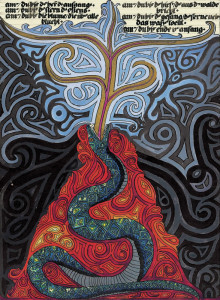
“You see, the Kundalini in psychological terms is that which makes you go on the greatest adventures. …It is the quest that makes life livable, and this is Kundalini; this is the divine urge.” — Carl Jung
Jung believed, though, that arousing the Kundalini had to be spontaneous, and not produced through the dangerous practices of Tantrism. He was not a fan of the left-hand path sexual cults (Too bad!) and never performed any type of formal meditation. But he did see meaning in the motion of the unconscious through Kundalini awakening. The Serpent aspect is not eliminated, or repressed, as it is on the right-hand path. This is one with the alchemical process of transmutation of the base self into something precious. You, your ego, is being elevated to a deified status (self-deification). It is the demon (Lilith) once more becoming the Goddess.
The Satanic Alchemy of The Sect
by Thomas LeRoy
We are all aware that alchemy is the ancient art of changing something of seemingly little value (lead) into something precious (gold). But it can also be interpreted psychologically. Alchemists had, over the course of centuries, created a vast amount of symbolic images that directly corresponded to the anatomy of the unconscious which the psychologist Carl Jung had been mapping through his work with thousands of patients. He discovered, much to his amazement, that this ancient art was symbolically describing the journey the individual must take towards embodying one’s own intrinsic wholeness, what he called “the process of individuation.” Jung insisted that the psyche cannot be understood conceptually, but only through images or symbols. He stated that, “The alchemical operations were real, only this reality was not physical but psychological.” He also wrote, “I had very soon seen that analytical psychology [the psychology Jung developed] coincided in a most curious way with alchemy. The experiences of the alchemists, were, in a sense, my experiences, and their world was my world. This was, of course, a momentous discovery. I had stumbled upon the historical counterpart of my psychology of the unconscious.”
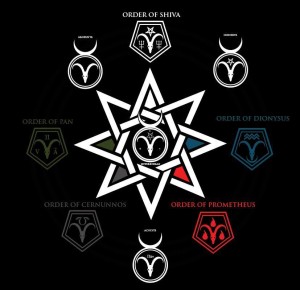
In The Sect of the Horned God the journey that the initiate takes as he/she progresses through the Orders can be described as an alchemical process. Each order has its symbolic element: Pan — Earth, Cernunnos — Air, Prometheus — Fire, Dionysus — Water. When the initiate has passed these four lower orders they become an adept, or Cenobite. The Cenobite utilizes the accumulated knowledge acquired in the Orders to bring about the quintessence, or fifth element, Aether. This process is done in the Order of Shiva to reach the degree of the Hyperborean. But If you are not willing to face what is sitting dormant in your subconscious, then the Order of Shiva may not be for you. This is where the Great Work, or the Transmutation, begins. You are the alchemical vessel and the contents of your psyche is the means and object of transformation. This alternative spiritual process cannot be reduced to simple recipes or axioms. It is the multi-level unification of microcosm with macrocosm to bridge the abyss between the ego and the subconscious; a descent into darkness in order to come to a reconciliation with your demon. This phase is the nigredo, or blackening phase of the alchemical process, and it is symbolic of coming to terms with this darker aspects of the Self.
But how does this come about?
First, for this process to work, you as a Satanist should have already come to the realization that you must divorce yourself from herd mentality. When your comfort zone becomes constrictive, like a beast outgrowing its cage, you must move beyond it. Still, only a few brave souls will venture beyond the walls of their self-imposed prison. If you are a member of The Sect, you have already done that. But still, spending a life-time of suppressing yourself, you have become a stranger to yourself. Alienation is felt as a chronic depression, deep inside. For some it is experienced at a greater level than others. Many try to numb it with a variety of means but there is no escape from yourself.
Through alchemical processes in the Order of Shiva you will come face-to-face with the Self, the Shadow Self, deal with its many complexities and learn to integrate it into your life. The world can be terrible, inexplicable and dangerous yet you must never surrender to pessimism by turning your back on it. Instead, learn to “transmute” the world and human life. Thus, you will become the Hyperborean (the Nietszchean “Higher Man/Woman) free from social constructs, attitudes, and restrictive dogmas with a strong will to power and its rational utilization. You will then accept the world in all of its highs and lows, mysteries and ambiguities having pulled yourself up out of ignorant bliss and stagnancy. You will find yourself amongst the doers, not the talkers, the maker and not the takers. You will be drawn to your processes, innovations, dreams and higher ideals. You will be aware and not ignore the arrival of peak experiences. Leave slave morality behind and have no guilt when you see yourself becoming compulsive and proactive.
When you have reached this stage, the game isn’t over, though. There is no “Aha!” moment where henceforth eternal bliss has been bestowed upon you. You must work to stay there. This is the point of individuation where the ego and the collective unconscious are brought into consciousness. It’s a fuller understanding of the Self and your individuality — a totally integrated personality. What you have done is accepted the contents of your unconsciousness, even those things that you would normally shy away from. It is the discovery of the divine in you. It is self-deification, the discovery of the god that you are.
Your Personal Demonic Sigil
by Thomas LeRoy
For a member of The Sect of the Horned God to enter the highest order, the Order of Shiva, one must have a personal demonic sigil, not taken from the Halls of Antiquities (not borrowed from the Goetia) but one entirely unique to the individual.
The adept’s personal sigil is fundamentally a visual construct, an artistic rendition of what lies in one’s own personal Hell — a glyph removed from the walls of Hades itself. Because of this, Its principle is found not in the external form, which is unique to each individual, but in the light of the individual’s Black Flame.
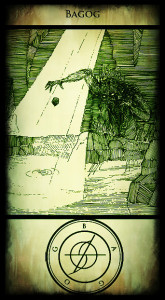
Symbolic systems are valid for human development to the degree that they point to a way of creative living. It is an unconscious synchronizing of the ego with the eternal collective unconscious. But a simple design, or arrangement of designs, does not a sigil make. Unless a personal, integrative principle is applied, an arrangement — even one of mathematical perfection — is void and without life. The source comes from the adept (Sect member) that opens up and reveals his/hers innermost details to the creator of the sigil. This is why it is important that the word, that one unique word, is the sum of the adept’s personal demon (daimon).
“Is there an entity from the depths of your subconscious that visits you in your dreams or visions? And what one word best describes this being?”
These are the questions asked of the adept when first entering the Sigil Project. Many are confused, finding these questions difficult to answer, but after the adept has let down his/her guard, the identity of the “demon” is revealed. Many have, during a sleepless night, or a feverish dream, encountered the demon. It may reveal itself as a nightmarish figure, or a disembodied voice. Some have heard this voice, or have seen this entity so plainly and so often they feel they have been inspired from the “outside”. But, in truth, it has arisen from inside, deep down. This is almost identical to what the ancient Greeks called the “daimon.” But in the case of the dark adept, one is not in touch with a wise being directing them with inspired counsel, but instead with the personified aspect of the Jungian shadow. And the relationship with this “anti-self” is capricious and unpredictable, but most find the experience cathartic.
Finding and the facing your anti-self, your shadow, is not a task for the weak of spirit, and most of the time it is so well camouflaged it can take a profound effort to discover it. We are naturally repelled by what appears to us as our personal negative aspects. But when we’ve acknowledged the demon’s existence within ourselves, and accept it’s qualities, we must listen well, for it has much to say as it unveils the diabolical secrets of Hell itself.
The Left-Hand Path to Hell
by Thomas LeRoy
The concept of Hell has been a part of history for at least 4,000 years. Many different cultures had some form of Hell, the Mesopotamian being one of the earliest. It was a nether region filled with demons where the ancient Gods consigned evildoers to suffer endless torment. The later Christian interpretation of Hell was built upon Hebrew ideas, which in time became, like in the case of the Mesopotamian tradition, a place of punishment for the wicked. But in the Old Testament, there’s only one word which indicated anything close to Hell, and that is sheol. It appears originally to have been the Hebrews’ version of the Sumerian and Babylonian Irkalla, or Netherworld, also referred to more poetically as “the House of Dust and Darkness.” Strangely, early Christians did not write extensively on Hell and appear not to have taken it as literally as many do today. But when documented, Hell was pictured as an inferno, a place of flames and cruel heat, where Satan lived and sinners suffered as demons boiled them in kettles or stabbed them with pitchforks, punishments tailored to fit specific sins.
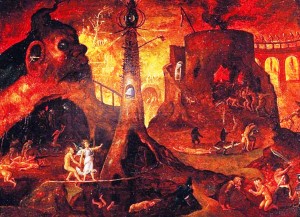
According to Carl Gustav Jung, Hell represents, among every culture, the disturbing aspect of the collective unconscious. The collective unconscious is universal. Every human being has been endowed with this psychic archetype-layer since his/her birth. One can not acquire this strata by education or other conscious effort because it is innate; for deep in our subconscious the same symbols speak to similar meanings across different cultures and unrelated time periods. The collective unconscious, this universal library of human knowledge, is the very transcendental wisdom that guides us. Jung stated that all religious experiences must be linked with the experience of the archetypes of the collective unconscious. Thus, all gods and demons, and even their locations such as Hell, are part of a psychic experience of the path that leads one to the realization of our psychic wholeness. In Jungian psychology, Hell would then be the place where the “shadow” resides. ‘‘The shadow,’’ wrote Jung, is ‘‘. . . that hidden, repressed, for the most part inferior and guilt-laden personality whose ultimate ramifications reach back into the realm of our animal ancestors and so comprise the whole historical aspect of the unconscious’’. The shadow was originally Jung’s poetic way of conveying the prominent role played by the unconscious in both psychopathology and the ongoing problem of evil. Also concerned with that pathological mental state known as ‘‘demonic possession”, Jung’s psychological construct of the shadow corresponds to, yet differs, from the idea of the Devil or Satan in theology. Born a parson’s son, Jung was inundated in the Protestant faith, he also studied the meaning behind Catholic iconography, and researched the great religious traditions from around the world. But, being a physician and psychiatrist, he used the more rational and less esoteric terms like ‘‘the shadow’’ and ‘‘the unconscious’’ instead of the traditional religious language of god, devil, or demons.
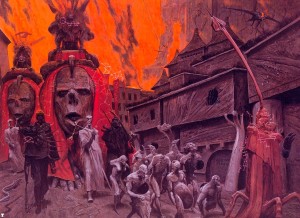
Just above the level of the collective Hell lies the personal Hell. This Hell is a place of personal demons that feed the shadow in the lower realm. And from time to time most of us feel a need to roam in this Hell. We all feel guilt, so we feel a need for torment, thus, we feel a need for Hell. The philosopher Friedrich Nietzsche described guilt as a disease that humanity caught when it formed its first social communities. But even though we live in artificial constructs we call nation states, under repressive executive authorities we call governments, our primitive instincts have never faded away. Instead, we turned our instincts for cruelty inwards upon ourselves because social laws prohibit violence. Because we internalize these instincts, we grow sick of existence. Nietzsche refers to this sentiment as the worst and most insidious illness ever to afflict human-kind. An illness from which we have not yet recovered.
So, as for us on the left-hand path, what are we to do? The collective hell is there whether we like it our not, but how should we confront this personal Hell of our own making? First, we must acknowledge that it is very real. Next, we must free up our minds and enter our personal Hell on our own accord, without that masochistic justification for torment created by guilt. We have to deny guilt and the Christian slave morality that permeates our society. In truth, we should have let guilt and slave morality go when we first set foot upon the Path. While in Hell, though, we must confront the dark entities that dwell in that abyss. We must stare them down, and in some cases, embrace them. But we should never turn our backs on them. Also, in the fires of Hell burns the source of our Black Flame, that spark of individualistic self-awareness. It was in our personal Hell that we first saw its glow, and from Hell we must lift it up and initiate it into our lives.
In the end we should never let our personal Hell curse our existence. It should be a means of empowerment for the Black Flame is fueled by Hell’s torments; and never forget that it is the Black Flame that lights our Path.
Understanding the Eastern Left-Hand Path Traditions
by Thomas LeRoy
Self-deification is not a proclamation, it is a process. One does not announce to the world that they are a god and henceforth reign supreme over all existence. Self-deification is something you strive to obtain, to reach, and once you have entered that state, you must work to remain there. You are then in a relationship with the deified self, and like any relationship you must work at it. A single slip-up and you can be cast out, back upon the Path, to try once more to re-enter. This is why it is important to have an arsenal of knowledge while proceeding down the Left-Hand Path. Some of you stepped upon the Path for the first time when you picked up The Satanic Bible. But The Satanic Bible was only your introduction. It was a mirror that you saw your reflection in. It was not the conclusion.
Reaching out, searching, learning about other modes of transport to help you down the Path is important. And understanding Eastern LHP philosophy is one way.
In the ancient Hindu traditions the Left-Hand Path, or the vamachara, was originally associated with the female aspect and the heterodox way. To put it simply, it is about reversing the natural spiritual flow. Eventually in the 19th century the Left and Right-Hand Paths were introduced into Western occultism by Theosophy founder Helena Blavatsky when she used them as terms to differentiate between white and black magick. To reach self-deification through the vamachara, or by any other practices, you must have a deep understanding of the Self. Atman, one of the most basic concepts in Hinduism, is the universal Self, identical with the eternal core of the personality. Atman is you, for in the early Vedas (holy Hindu writings) it occurred mostly as a pronoun meaning “oneself”. So atman is that which is then “deified” at the end of the LHP. Brahman, on the other hand, is the Absolute. Brahman underlies the workings of the universe, and atman is part of the universal Brahman. Brahman, in Vedic philosophy, is the “World Soul” and is regarded as being the “Three-in-One God” known as the Trimurti. This consists of Brahma the Creator, Vishnu the Preserver, and Shiva the Destroyer, all manifestations, or personifications, of Brahman.
Shiva, with his wild, unpredictable and destructive nature, is perhaps the ideal personification of the eternal core of the personality, or atman. His violent essence is often conveyed through the use of metaphorical images which are designed to resonate with the subconscious. However, Shiva’s destructive persona is not to be feared. The fury of Shiva’s fire only burns away the walls of ignorance. The atman is indestructible; thus, Shiva’s fire represents the awakening of the Self to its true nature and its god-like status. Because of Shiva’s association with the Self, some Shaivists have rebelled against the standards of the orthodox Hindu community. Believing that Shiva is the Self, they can make their own rules; and since all things, good or bad, are an aspect of the Absolute, nothing is taboo. Thus, they carry out bizarre sacrificial and sexual rituals, eat meat (sometimes human), and use mind-altering intoxicants while chanting “Shivoham!” — “I am Shiva!” They believe these activities to be short-cuts to self-deification. But they are not trying to become one with Shiva. Instead they long to deify the atman to become Shiva. A god!
You practitioners of the Western Left-Hand Path traditions may not have much interest in Eastern Philosophy. It may seem odd and confusing because in the Vedic traditions they attempt to say with words that which can not be said with words. It is metaphorical, it is poetry, and it is meant to be experienced, not critically analysed nor blindly believed. But still it is important that one is aware that there are other deities besides Satan and Lucifer that speak to our inherent nature. And Shiva speaks loudly. If you but only listen.
